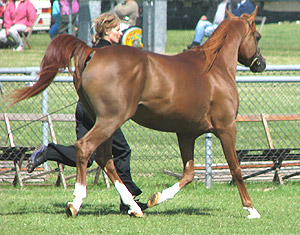
Testing For Shoulder Lameness in a Horse or Pony
 It is not always easy to locate
or diagnose the source of lameness in a horse, or sometimes to decide
exactly which leg it is lame on.
It is not always easy to locate
or diagnose the source of lameness in a horse, or sometimes to decide
exactly which leg it is lame on.
Shoulder lameness is not a common occurance in horses, some vets will only see one or two cases of shoulder lameness a year. What looks like a shoulder lameness can often be due to a problem in the foot.
But if you suspect that horse my have a shoulder injury there are a few tests that you can do yourself.
As always you should get an veterinary surgeon to examine the horse if it is in pain to determine the cause and advise appropriate treatment.
OBSERVE THE HORSE WHILE IT IS RESTING
If you suspect that the lameness is coming from the shoulder first observe the horse while it is resting in the stable or in the field.
A sound horse frequently rests one hind leg, but will normally have his weight evenly distributed on both forelegs, unless he is very tired when he may rest each foreleg alternatively.
If a horse is lame in the shoulder the lame leg usually appears to hang down and may be slightly behind the other foreleg.
TROTTING THE HORSE UP TO TEST FOR SHOULDER LAMENESS
Once you have observed the horse while it is resting take him outside to trot him up.
First of all look at the horse in walk. Have someone walk the horse towards you, past you and away from you on a loose rein on a smooth level surface. A severe lameness will be evident in walk.
Repeat this in trot, The horse will take a shorter stride with the unsound leg. If it is lame in one of his front legs he will drop his head as the sound foot comes to the ground, then raises it to take the weight off the leg which is causing him pain.
Sometimes in shoulder lameness a horse will swing the lame leg slightly or catch his toe on the ground. If you suspect that the horse is lame in the shoulder there are further tests that can be carried out.
TESTS FOR SHOULDER LAMENESS IN A HORSE OR PONY
To find out if the pain is in the shoulder pull the horse's leg forwards and then backwards as far as it will go two or three times, and if he flinches or is inclined to rear up, he is probably feeling some pain, and if you have him trotted directly after this treatment he will probably go lamer than before.
Some horses are inclined to resent this manipulation, so both shoulders should be tested.
A further test for shoulder lameness is to trot the horse uphill and down. If lame in the shoulder, he will be more lame going uphill than down. In the case of foot lameness the reverse is the case.
VETERINARY DIAGNOSIS OF SHOULDER LAMENESS
Ultimately it may be necessary to call out you vet to determine the cause of lameness. He or she may want to do blocking, xray and scans to confirm the diagnosis.
A vet can inject a local anesthetic to determine if the seat of lameness lies above or below the point of injection.